The gestation period for kittens in domestic cats is 61-67 days, with a normal gestation period of 63 days. In order to fully monitor the course of the pregnancy and to establish the exact date of delivery, the owner must know the date of conception.
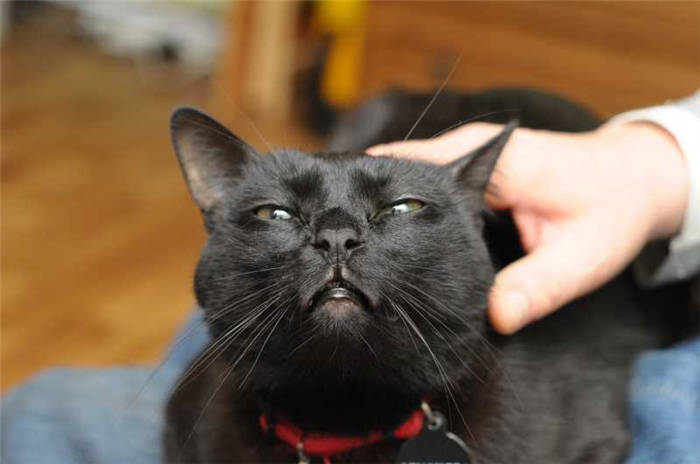
- 🐱How to know if a cat is about to give birth
- Signs of the beginning of labor
- Cramps and kittens in labor
- Physiological signs of an early labor
- How to know if a cat is giving birth?
- First Signs
- Signs that labor has already started
- Stages of labor
- How can a person help an animal?
- Antecedents of labor in sphinxes
- Signs of labor in British and Scottish breeds
- Pregnancy in cats, important nuances
- Preparing for birth
- Physiological signs
- Harbingers of an imminent birth
🐱How to know if a cat is about to give birth
Experienced breeders when breeding pedigreed cats usually know the exact date of mating, the gestational age of the cat. Therefore, it is not difficult for them to accurately determine that the cat is about to give birth.
But what if the owner did not plan the mating, or does not know when it happened?
This often happens when domestic non-sterilized cats are taken to the country house, or given free range on the street.
There are a few basic signs you can tell when a cat's due date is approaching.
Normally, a domestic cat's pregnancy lasts about sixty-five days. A cat can become pregnant from as early as five months of age, but this certainly depends on her individual characteristics.
The first heat in cats usually begins at 5-9 months of age. During the heat, the cat becomes more affectionate, actively meows, pats and rolls around on the floor. If mating occurs during the heat, the cat is likely to become pregnant.
The cat's appearance may not change during pregnancy. Some owners mistakenly believe that she should immediately grow a large belly.
But in practice this is not entirely true, and pregnancy can be outwardly unnoticed almost until the birth.
It depends on the breed, age and build of the cat. If the owner believes that the cat may not have become pregnant as planned, it is better to take her to a veterinarian for a checkup.
But it is worth bearing in mind that the vet will only be able to tell if the cat is pregnant from the third week onwards.
The most accurate signs that a cat is about to give birth are changes in its behavior.
Some owners may notice that the cat's taste preferences have changed, her appetite has increased or decreased.
Nausea and rapid fatigue may occur. Some cats may have increased frequency of urination.
The cat may begin to hide in hiding places and choose a place to give birth.
The owner should be concerned about swollen mammary glands of the cat or changes in their temperature, by the time the birth approaches, they may become hot.
Signs of the beginning of labor
An inexperienced owner may find it difficult to understand that a cat has gone into labor. Especially keep in mind that contractions can be false. In the last days of pregnancy, the cat's behavior will change, which will be a signal to the owner of the upcoming event. Clear signs that labor is beginning are:
- Enlargement and reddening of the mammary glands;
- Swelling of the genitals;
- The abdomen lowers and becomes pear-shaped;
- intensive licking of the genitals (there should be no discharge);
- frequent urination;
- loss of appetite;
- Sluggish behavior, excessive attachment to the owner.
Just a few hours before the birth the cat may become restless, meow loudly and not be able to find its place. She also begins arching her back as if she were having contractions. These contractions of the uterus are not contractions as such. However, they are harbingers of contractions. If a cat exhibits this behavior, you should expect her to give birth in a relatively short period of time.
False contractions are often noted several days or even weeks before the anticipated start of labor. In this case, the behavior of the animal should be closely monitored. If false contractions cause your cat considerable discomfort, genital tract discharge (especially bad smelling), or if she becomes too lethargic and refuses to eat or drink at all, you should show her to the vet.
Cramps and kittens in labor
- Beginning of labor activity. The uterus begins to contract, the first not too intense muscle contractions appear. At this time, the kittens are getting ready to "go out" and line up before passing through the birth canal. At the first stage, it is not always possible to realize that a cat is in labor. They are invisible and do not cause significant pain, so the animal will not react strongly to them. The contractions will usually recur at 30-40 minute intervals. Gradually the interval will shorten and the duration of the contraction will increase. This period may last 8-10 hours.
- Passage through the birth canal. The contractions intensify and the interval between them shortens to 1 minute. Muscle contractions become distinct and easy to see with the naked eye. The final contractions, long contractions of the muscles, are also called pushes. They push the kitten through the birth canal. Due to the increased intensity of the contractions, the fetus begins to come out.
It may take about 12 hours from the beginning of the first contractions to the birth of the offspring. If kittens are not born for a longer time, you should seek help from a veterinarian. During prolonged inactive labor, the fetus may experience hypoxia – oxygen deprivation, which negatively affects its health and can lead to death.
Physiological signs of an early labor
When the delivery date is very close, the cat's behavior and condition change very noticeably. She becomes lethargic, apathetic, and spends a lot of time in the nest. Some cats, on the contrary, become restless, constantly following their owner, considering him as a guarantee of "moral support" and physical safety.
This is especially true for first-born cats, which have a poor understanding of what is happening to them and rely on their owner for help. Cats that have become pregnant for the first time should be given special attention: when frightened, the animal, ignoring the comfortable nest, may crawl under the sofa or a closet and begin to give birth there.
Two or three days before parturition the cat's belly lowers, the mammary glands swell, and some individuals begin to secrete colostrum from their nipples. This can be seen by lightly pressing on the nipple toward the tip. The cat goes to the toilet more often than usual because the uterus, which has increased in size and descended before delivery, presses on the bladder.
The cat may stop eating the day before delivery, but it will drink water in usual amounts, so there should always be a bowl with fresh water near the nest. A cat often and very actively licks its genitals: it is both a hygienic procedure and an instinctive method for stimulating the labor activity. Mucus plugs coming out of the cat's birth can go unnoticed during the same period, if the birth plug has come out while emptying the ureter or intestines.
Signs of close labor also include a slight change in body temperature, from the usual 38 – 39 ° C it may fall to 37 ° C. In the pre-partum period, the cat's body is under severe stress, which may even be accompanied by vomiting. Such phenomena are not considered pathological and do not require intervention.
A cat may develop so-called "training contractions", caused by short-term contractions of the uterine muscles, a few hours before the start of real labor. The cat tenses for a few seconds, arching its back upwards, and then lying down quietly again. This phenomenon can be considered the start of labor.
How to know if a cat is giving birth?
It is impossible to predict the time of labor in a cat, since the pregnancy of each pet proceeds according to its individual characteristics.
However, there are a number of signs that can be used to determine when kittens are about to be born:
About a week or a few days before the birth, the cat's behavior changes, becoming more nervous and even aggressive. It may avoid contact with people or, on the contrary, it will attract attention and call its owner.
During this period the cat seeks a secluded corner, it may climb into cabinets, hide under the bed. The owner should arrange a suitable place in advance and show it to the cat to get her used to it.
The cat may intentionally pull the hair around the nipples to facilitate access to milk for future kittens.
One to two days before delivery, the cat's mammary glands swell and produce some colostrum (the first milk, rich in antibodies that boost kittens' immunity).
The cat's appetite decreases up to complete refusal of food, she also drinks less.
Activity decreases. The cat lies more, may look apathetic and indifferent.
The day before labor the cat begins to actively lick itself – this is due to the fact that before the birth of the genitals the protective mucous plug comes out of the genitals.
A few hours before labor (about 5 hours) the cat has a characteristic curve of its back, this is due to the occurrence of short contractions of the uterus.
The cat's labor often occurs at night. In order for the birth to be under the owner's control, it is necessary to monitor the pet's condition not only during the day, but also at night.
First Signs
Friends, first of all I recommend to refer to your memory and remember when the mating occurred. Pregnancy lasts 65-70 days and even if you don't know the exact day of conception, an error of a few days is not critical. This is the first actual sign that labor is near.
The second sign of an impending addition is altered pet behavior.
In about 2-3 days, the pet will actively look for a place to give birth, choosing darkened corners, a pile of clothes, or a recessed place in a closet. Don't disturb your pet, but offer a more accommodating option – a box or crate with a disposable diaper underneath.
A third symptom can be considered a change in body temperature. A cat's normal temperature does not exceed 39 degrees. When labor approaches, the temperature may drop to 37 degrees. Check out this article on how to take a cat's body temperature.
The fourth sign of impending labor is the appearance of colostrum. This is easy to check. Look to see if the cat's mammary glands have swollen. Usually the nipple is swollen and becomes a soft pink shade. Pressing on a nipple may produce colostrum.
If the cat behaves unnaturally, cannot sit in one place, is hunched over, you probably see the sixth symptom of labor – training contractions.
It is important to know that these "markers" may or may not be present together. The only accurate way to determine if labor is coming is to count it from the day of labor.
Signs that labor has already started
If you are reading this article and do not see the first signs, then most likely the labor process has already begun. The animal's body prepares just like the human body: the cervix opens and contracts. This stage passes unnoticed by the owners, but it can be determined by an experienced veterinarian.
- The animal tries at all costs to get to the place it has found in the house and chosen for the birthing stage: it does not sit in its arms, snaps and returns to its "nest". Do not worry if at this time your pet refuses food. Put clean warm water and light fat-free food nearby. In fact, here is a separate article on what to feed the cat, read it.
- The birth plug has come out – a pink bubble, at first glance, and a red clot if the plug has already come out. You can see it on the bedding or notice it when the cat eats it.
- An abundance of mucous amniotic fluid with a yellow tint. If the cat is already in its seat, you can tell if the fluid is coming out by touching the bedding. If the bedding is wet, replace it. I generally advise buying a disposable diaper so that you can get your kitty comfortable quickly and quickly.
These are three sure signs that labor is near. After the amniotic fluid is released, the first kitten can be expected within a few hours. Watch Athena's video, she explains all the points by showing on her kitty:
If you have anything to add, please post in the comments. At this crucial time of replenishment, every piece of advice will come in handy.
Stages of labor
Contractions are the first stage of labor. They usually last for 2-3 hours, gradually becoming more frequent and stronger. The cat breathes hard and often with its mouth open. If you put your hand on her belly, you can feel the spastic contractions of the muscles. Normally, the first kitten should appear no later than 3 hours after the beginning of this period.
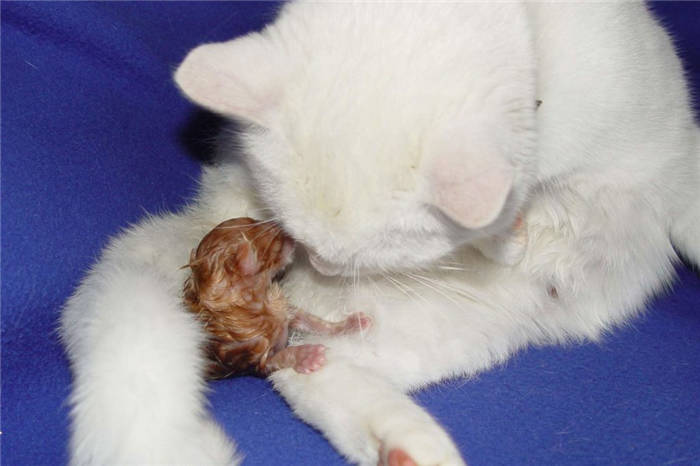
The second stage is pushing. The cat is pushing intensively, pushing the kittens out through the birth canal. By the time you give birth, the babies are usually with their heads toward the exit, but some may be born with their legs forward. Usually the kitten emerges in four to five pushing movements.
In the uterus, the fetus is in the amniotic bladder, which bursts beforehand, pouring out amniotic fluid. However, the bubble does not always burst, and some kittens are born in it. The cat itself bites it and licks the offspring, cleansing it of mucus. The babies should squeak – this is a sign that the airway is clear.
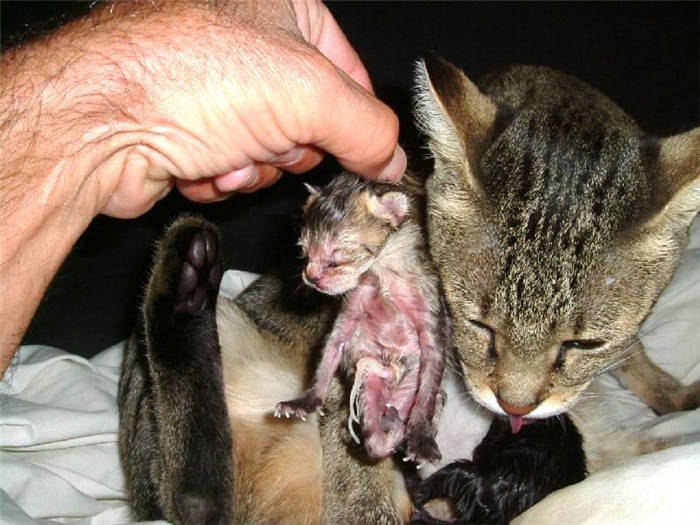
The final stage of labor is the expulsion of the afterbirth. Make sure that as many afterbirths come out as the number of kittens were born. Placenta remaining in the uterus will cause infections, the consequence of which may be the need to remove the organ.
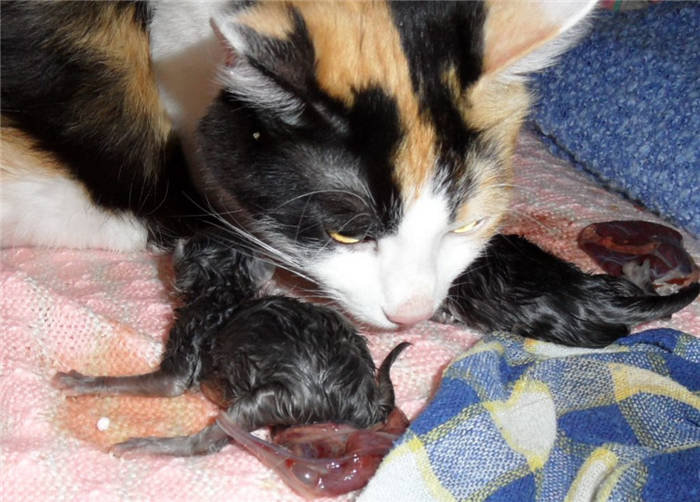
The cat itself bites the placenta and eats it. There is no need to prevent this, because the placenta contains many nutrients and hormones that stimulate lactation.
When all the babies are born, the cat lays down to them and begins to feed. It is not necessary to touch the babies at this moment, so that the mother does not give them up.
How can a person help an animal?
Normally, healthy and strong cats give birth on their own. All that is required from a human is to supervise the process, attention and care for the cat. Not all purebred cats are in good health, especially if the cat is going to give birth for the first time, she may need help from the owner.
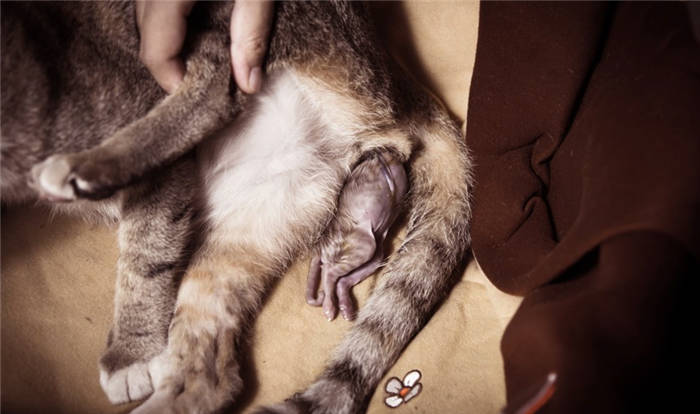
- Kitten stuck in birth canal. Happens due to sudden cessation of labor activity, weak pushing, improper positioning of the fetus. You need to lubricate the vagina and vulva with Vaseline, which will ensure easier passage. Intramuscularly, an injection of Gamavit is made into the thigh according to the instructions.
- Opening of the amniotic bladder. If the pregnancy was multiple, the female may not have the strength to open the bladder of the last kittens. It is incised with sterilized scissors, the baby is carefully extracted, the remnants of amniotic fluid and mucus are collected with a pipette, wiped with a towel and placed on the mother's nipple.
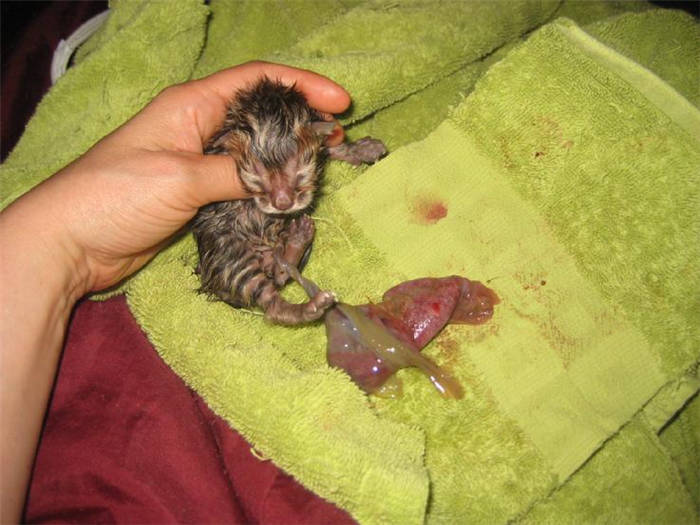
- Cutting the umbilical cord. First-born purebred cats often do not have the maternal instinct right away. For example, they refuse to chew the umbilical cord. This can be done on its own by first pulling it with a thread at a distance of 4 cm from the abdomen. The cut place is treated with antiseptic.
- The kitten shows no signs of life. Perhaps his airway is clogged with mucus, which is sucked out with a pipette. Then his back is rubbed with a towel for about 3-4 minutes with his face down and lifted by his hind legs.
Read also: When does a cat's first heat start, how many days it lasts and how often it happens, what to do to calm the pet?
Antecedents of labor in sphinxes
Don and Canadian sphynxes are exemplary and caring mothers for their little kittens. The gestation period lasts from 58 to 72 weeks. In most cases, cats of this breed produce 3 to 5 kittens per calving.
The first signs of the beginning of labor in sphinxes appear 2 days before the upcoming event. Two days before labor begins, the body temperature in the rectal passage drops to 36.7 degrees. The cat begins to actively nurse and scrub the genital area.
A few hours before labor, the cat begins to arch its back and show pronounced anxiety. Otherwise, the signs of beginning labor are similar to other cat breeds, and the labor process itself takes about 12 hours until the last kitten comes out.
Please note! If contractions last longer than 3 to 4 hours without any pushing, you should contact a veterinarian for help.
Signs of labor in British and Scottish breeds
In most cases, there is no difference between births in other cats and purebreds. Cats of British breeds are more attached to their owners, so before the birth the cat begins to follow its owner, trying to find support, for fear of being left alone.
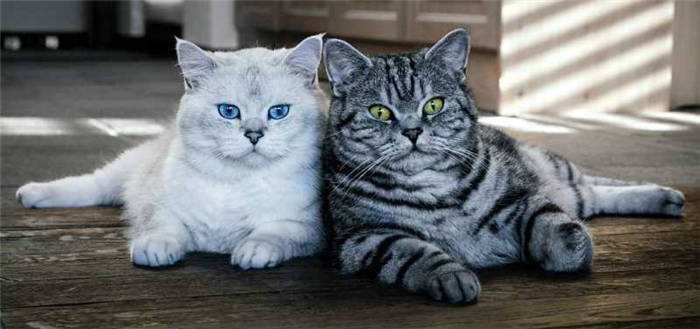
It is very important to prepare for the birth of a Scottish cat in advance, and it is better to have her under the supervision of a veterinarian or professional breeder if the cat is giving birth for the first time. As a rule, the kittens in this breed of cat are large and complications may arise in the process of delivery. Due to the breed characteristics of British and Scottish cats, they can suffer pelvic fractures in childbirth, and bleeding can occur.
Pregnancy in cats, important nuances
Pregnancy in cats follows a certain cycle. According to generally accepted rules, cats of value should be bred. If everything is done according to the rules, the mating is planned and registered in the breed club.
As practice shows, most inexperienced owners encounter pregnancy of their wards already after the fact, not keeping track of their wards during heat. The first sign of pregnancy can be considered the absence of heat, which should come according to the cycle. Usually the cycle is 3-4 weeks. So, if your cat has not started meowing and calling the cat, it is worth analyzing if she might have had contact with the male during the last heat.
If your cat is not of breed value, to avoid pregnancy and the hassle associated with it, it is recommended that you spay your pet before the onset of heat. With a responsible approach, you'll keep your cat healthy and won't have to deal with the problem of "fostering" kittens.
By a strange "tradition" it is believed that a cat carries and gives birth to kittens without complications. In fact, the planning of pregnancy and care of the expectant mother is of enormous importance. Like all living creatures, cats are under serious stress while carrying their young and need increased nutrition and care. After the birth of kittens, many, especially purebred cats, may suffer from complications.
Please note! In early pregnancy the owner has a choice – medical abortion or castration of the cat. In late pregnancy, the owner will have to accept and take responsibility for the life and health of the kittens.
Whether you wanted to have kittens or not, as soon as you find out that the cat is pregnant, she needs to be seen by the vet. Both parents are vaccinated and parasite-free before the scheduled mating. If preventive measures have not been taken before mating, some can be done in the first trimester. Some types of parasites can infect kittens in utero, leading to serious postpartum complications or death of the entire litter.
Preparing for birth
One to two weeks before delivery, the cat will begin what is called nesting. Usually from the 7th week of pregnancy the cat starts to look for a comfortable shelf in the closet or other shelter that will become a nest. At this stage it is strictly forbidden to let the cat out for walks, because it can set up a nest outside the house.
Monitor the cat's behavior carefully and do not interfere unless absolutely necessary. If a cat decides build a nest in your closet, it is wise to give her a shelf instead of moving the nest to a place that is more comfortable for you. Preparing the nest should be paid attention if only because the cat may give birth on your bed, clothes, or a stack of clean laundry.
Important! During the process of giving birth and feeding the offspring, the cat should be shielded from stress as much as possible.
You can avoid negative consequences if you prepare a nest for giving birth yourself. Special boxes are sold in stores that are outfitted as maternity nests. In fact, any sturdy cardboard box with high walls.
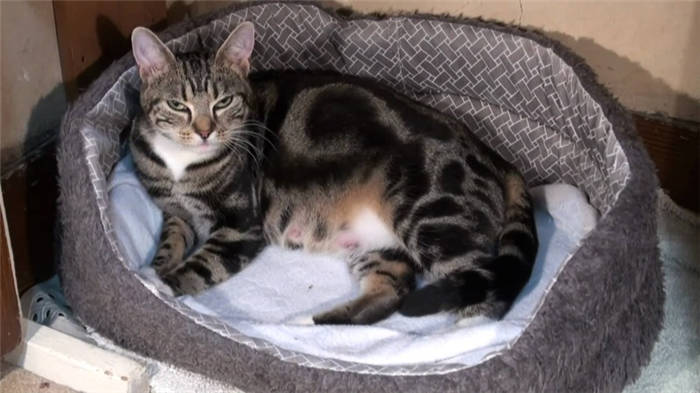
One wall is cut off, leaving a rim over which the cat can easily step. When preparing the nest, it is better to stock an additional box, because during the delivery of the cardboard can get wet and tear.
Important! Before making a nest box, check that it is not bound with sharp staples or glued with toxic substances.
Consider in advance how to cover the top of the box so that the cat feels secluded and at ease. A few days before labor and the onset of labor, most cats become withdrawn and try to hide. For an expectant mother who will give birth for the first time, it is better to equip several nests at once. Before the birth, the cat will choose the best and safest (from her point of view) place.
Physiological signs
There are not many physiological signs of the beginning of labor activity, before the onset of strong contractions. The most telling sign is the cat's baseline body temperature. During pregnancy, the temperature may fluctuate throughout the day, but changes in readings do not exceed 1 degree.
A few days before delivery, the cat's body temperature stabilizes and will not change. The cat becomes less active, will sleep longer and eat more often. About a day before delivery, the cat's baseline body temperature begins to decrease. It usually drops to 37-37.1 degrees. If you have recorded that the body temperature has dropped, the measurements should be stopped. At this stage, all you can do is to calm the cat and wait calmly for the birth to occur.
Please note! The cat's body temperature is measured rectally, as any other way of measuring gives a high degree of inaccuracy. A few hours before labor your body temperature will stop dropping. From this point on there is no need to measure the temperature.
In many cats, swollen and reddened nipples are seen as a physiological sign of pregnancy. The degree of change depends on the hormonal background. In most young cats whose pregnancies are normal, the first nipple swelling can be seen at 2 to 3 weeks of pregnancy. A few days before delivery, the mammary glands swell more, may become hot and richly pink.
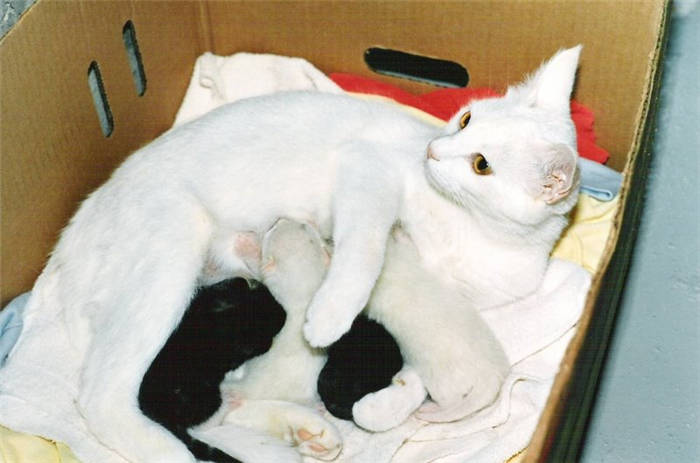
On the day of labor, usually a few hours before the onset of strong contractions, the expectant mother's mammary glands begin to secrete a clear fluid. This is how the body prepares for the production of colostrum. Cats with high hormonal levels may experience the beginning of lactation even before labor begins.
If you notice one or more physiological signs of impending labor, monitor the cat's condition carefully. The onset of labor is indicated by increased breathing and heartbeat. Many cats, especially those with flat and depressed noses, breathe intensely with their mouths open. Make sure that the cat keeps its head above the bedding (not sticking its nose into the cloth). If possible, ventilate the room in which the nest is located.
Harbingers of an imminent birth
It is customary to divide a cat's labor into three stages. The onset of the first stage of labor is called precursors. Normally, a mucus plug comes out of the birth canal before labor begins. However, you should not rely on this sign for several reasons. The mucus plug can be very small and come out during urination. This process will be unnoticeable not only for you, but also for the expectant mother. Moreover, many experienced owners tell that they have observed the rejection of the mucus plug a few weeks before labor.
The first contractions occur at intervals of up to 30-40 minutes. There is little pain, so the cat may behave as usual, except for being more anxious. As the contractions intensify, the mother-to-be will ignore food and stay close to the nest. More often than not during the first stage of labor the cat is active, you might say eager to drink water. You may notice that the cat goes to the litter box frequently, but does not empty her bladder or bowels. This behavior is due to a pulling pain in the peritoneum that feels a little like urges to urinate and defecate.
The movement of the first kitten toward the birth canal can provoke urges to defecate. Most cats go to the litter box to relieve their need. If you notice that the cat has already started contractions and has gone to the litter box, be careful that no fetal bladder appears in the birth canal during defecation. If this happens, gently take the cat in your arms and carry her to the nest.
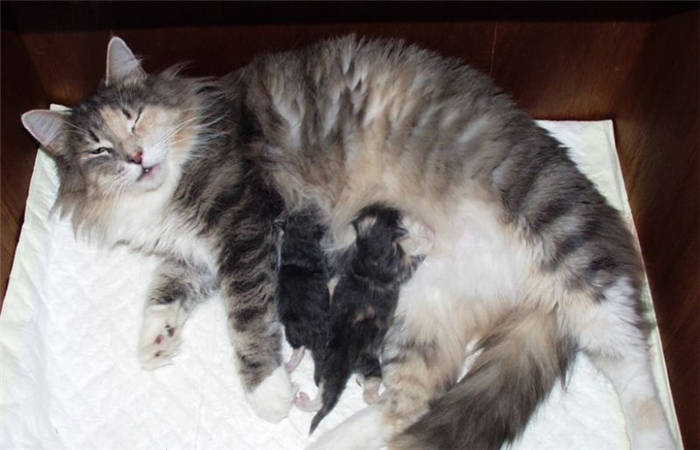
Contractions become evident after the onset of phase 2 of the first stage of labor. The peritoneum is almost constantly in tension, muscle contractions are visually visible and well palpable. At this stage the cat breathes frequently and shallowly, tries to lie on its side and lick itself. Normally, after the beginning of strong contractions and before the onset of labor, it will take no more than an hour.






